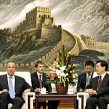
RUSSIAN OFFICIALS AND MEDIA HAIL DEAL CEDING ISLANDS TO CHINA
Publication: Eurasia Daily Monitor Volume: 5 Issue: 145
By:

Russia moved to finalize its border arrangements with China in an apparent bid to prop up its bilateral “strategic partnership.”
On July 21, Russia and China signed an agreement that finally settled the demarcation of their 4,300-kilometer (2,672-mile) border, the longest land frontier in the world. Russian Foreign Minister Sergei Lavrov and his Chinese counterpart Yang Jiechi signed the border agreement, which involves the handover by Russia of two river islands.
Russian officials inevitably hailed the deal. The border agreement was reached in the course of dialogue, based on principles of equality and mutual respect, Lavrov announced in Beijing. The final demarcation of the border between the two nations creates new opportunities for border trade and cooperation between regions, said Lavrov, who also met President Hu Jintao and Premier Wen Jiabao during his visit to Beijing (Interfax, ITAR-Tass, RIA-Novosti, July 21).
The border agreement was apparently designed to cement the bilateral “strategic partnership.” Lavrov told Hu that Russia prioritizes its relations with China in its foreign policy. “It is highlighted in the latest version of Russia’s foreign policy blueprint, recently approved by President Medvedev,” Lavrov said (Interfax, July 21).
As the border deal was finalized, Moscow also made other overtures to please China. Lavrov said Russia and China discussed the expansion of visa-free travel between the two nations. In an apparent gesture toward China, Lavrov announced that Russia’s Prime Minister Vladimir Putin is due to attend the opening ceremony of the Beijing Olympic Games next month (Interfax, RIA-Novosti, July 21).
Russian officials were keen to reiterate that the border deal would not harm Russian interests, but were somewhat shy to mention that the agreement involved land transfer to China. “We did not discuss territories, [we discussed border demarcation]”, Lavrov said on July 21 (Interfax, July 21).
The agreement ends the border demarcation, a subject of talks between the two countries for more than 40 years, the Russian Foreign Ministry said on July 18. The ministry also described the agreement as “a big event for the two countries” (Interfax, RIA-Novosti, July 18).
China-Russia border disputes go back centuries as tsarist Russia and imperial China expanded toward each other. The former USSR and China were allies through the 1950s, before the relationship became hostile in the late 1960s as two nations edged to the brink of war over the border dispute. At this point, the Soviet Union was believed to have deployed over 700,000 men along its border, facing as many as one million soldiers of the People’s Liberation Army (PLA).
However, Russia and China signed two border agreements in 1991 and 1994 delimiting the eastern and western sections of their frontier, while a minor portion of the eastern section was not resolved.
In October 2004, when Vladimir Putin, then Russian president, visited China for talks with President Hu Jintao, both sides signed the final border agreement on the eastern sector of the border. The joint statement described the agreement as “balanced” and a “win-win” solution. In May 2005, the state Duma, the lower house of the Russian Parliament, ratified the agreement.
The agreement involves the area of the Bolshoi Island, in the upper reaches of the Argun river, Chita region, and the area of the Tarabarov and Bolshoi Ussuriisky Islands, situated at the confluence of the Amur and Ussuri rivers near Khabarovsk, not demarcated till now. Those two sections make up less than two percent of the Russian-Chinese border.
Under the agreement, the border will divide both areas (some 375 square kilometers) between Russia and China almost by equal shares. Part of the Bolshoi Ussuriisky island and the whole of the Tarabarov island will be handed over to China.
However, Chinese media made little secret that the agreement was seen as a territory hand-over by Moscow. “Russia will soon return 174 square kilometers of territory on the northeast border to China, ending more than 40 years of negotiations,” China Daily wrote. According to the agreement, Russia will return Yinlong Island (Tarabarov Island) and half of Heixiazi Island (Bolshoi Ussuriysky Island), the daily continued (China Daily, July 21).
The official Russian media predictably backed the deal. “There are no more territorial disputes between Russia and China,” the state-run RTR Channel said in its report on July 21. The border issue, which had complicated bilateral relations, was solved, the report added.
Other media organizations also refrained from criticizing the deal. The border dispute with the Chinese ended, the popular Komsomolskaya Pravda daily wrote on July 21. The tabloid Moskovsky Komsomolets described the deal as a “present to China” (Moskovsky Komsomolets, July 21).
In the absence of comments by mainstream politicians, only radical critics of the Kremlin lashed out at the deal. The border agreement amounted to “shameless” surrender of Russia’s territory designed to appease China, opposition politician Eduard Limonov told the Ekho Moskvy Radio on July 21. Such an agreement should have been subject to approval in a referendum, said Limonov, who heads the radical National Bolshevik party, currently banned by the Russian authorities.
Therefore, Russia finalized its controversial border agreement with China amid apparent absence of any public discussion as few dared to criticize the deal. Yet it remains to be seen whether the border pact could serve to strengthen the bilateral “strategic partnership.”




